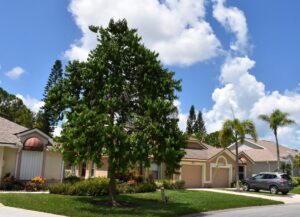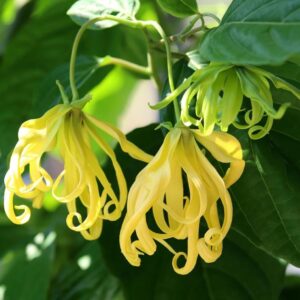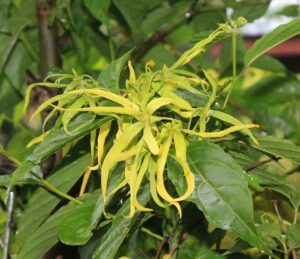Discover the Ylang-Ylang Tree Growing and Care Guide. Learn how to nurture this beautiful plant and raise a flourishing green oasis.
Explore the Ylang-Ylang Tree Growing and Care Guide to uncover the ideal conditions in which this aromatic plant thrives. Find what it appreciates the most for a garden that flourishes with beauty and fragrance.
Learn How to Grow Toona Sinensis ‘Flamingo’ Tree
What is Ylang-Ylang Tree?

The Ylang-Ylang tree (Cananga odorata) is a tropical evergreen tree that belongs to the Annonaceae family. Native to Southeast Asia, particularly in countries like Indonesia, Malaysia, and the Philippines, this tree is renowned for its striking appearance and captivating fragrance.
This tree features glossy, dark green leaves that are elongated and lance-shaped. The tree can reach an impressive height of up to 20 meters (65 feet) when grown outdoors in its natural habitat. However, when grown indoors or in containers, it tends to be smaller and more manageable, typically reaching heights of around 2 to 3 meters (6 to 10 feet).
One of the remarkable characteristics of the Ylang-Ylang tree is its highly fragrant flowers. These pendulous, star-shaped flowers have vibrant yellow-green petals and emit a sweet, exotic scent that is often described as floral and fruity.
Botanical Name: Cananga odorata
USDA Zones: 9-11
Learn Tips for Growing Apple Trees in Pots
Propagating Ylang-Ylang Tree

Ylang Ylang Tree can be grown by many methods, such as; seeds, cuttings, and air-layering. The best ones are seeds and cuttings.
From Seeds:
- Collect ripe ylang-ylang tree seeds from mature fruits that become brown or yellow.
- Clean the seeds and soak them in water for 24 hours. It will boost germination.
- Fill small pots or trays with a well-draining soil mix.
- Plant the seeds at a shallow depth of up to 1 inch in the soil.
- Keep the soil consistently moist but avoid overwatering.
- Place the pot in a warm location with temperatures of 75-85°F (24-29°C).
- Provide bright, indirect light for the seeds.
- Be patient, as germination can take weeks to months.
- Once seedlings emerge, ensure good airflow and consistent soil moisture.
- Transplant seedlings when they have developed true leaves.
From Cuttings:
- Take stem cuttings during the growing season (spring/early summer).
- Cut a healthy, semi-hardwood branch below a leaf node about 6-8 inches long. Make sure the cutting has 2-3 sets of leaves.
- Remove lower leaves, leaving a few at the top.
- Dip the cut end in the rooting hormone.
- Fill a small pot with a well-draining soil mix. Plant the cutting, burying at least two nodes in the soil.
- Place in a bright location with indirect light. Water thoroughly and maintain slightly moist soil.
- Increase humidity by covering it with a plastic bag or dome. Monitor moisture levels and mist the leaves occasionally.
- Roots should develop in a few weeks to months.
- Transplant to a larger pot or directly into the ground when roots are established.
Learn How to Repair Tree Struck by Lightning
Best Pot for Ylang Ylang Tree
While Growing Ylang Ylang in pots, it’s important to consider the tree’s stage of growth.
- For seedlings, a small pot with a diameter of 4-6 inches is suitable.
- While young trees will require a larger pot of 8-10 inches in diameter.
- As the tree matures, use a pot with a diameter of at least 16-20 inches or larger to accommodate its root system.
When choosing a pot, ensure it has drainage holes to prevent waterlogging and select a durable and non-porous material such as terracotta or plastic.
Conditions for Growing Ylang Ylang Tree

Sunlight
To ensure proper light care for a Ylang Ylang tree, it is essential to provide it with adequate sunlight. These trees thrive in full sun and require at least 6 hours of direct sunlight daily. It is best to position the tree where it gets optimal exposure throughout the day.
Soil
When you grow a Ylang Ylang Tree, it’s important to use soil that drains well and has a pH level that is slightly acidic to neutral, between 6.0 and 7.0. A good soil mix is made up of loam, sand, and organic matter like compost. This type of soil helps water flow through it easily while still keeping enough moisture for the tree. It also allows the roots to get the air and nutrients they need.
Water
Make sure the soil around the Ylang Ylang Tree is always moist but not soggy. The tree likes to be watered regularly, especially when it’s growing actively.
When you water the tree, give it enough water so that the soil can soak it up. Afterward, let the top layer of soil dry out a bit before watering it again. Be careful not to overwater because that can cause root rot and create other problems.
Temperature and Humidity
The Ylang Ylang Tree grows best in warm and humid places. It likes temperatures between 70 and 90 F (21-32 C). Keep the tree away from cold drafts and frost because it doesn’t do well in low temperatures.
To give the tree enough humidity, spray water on its leaves often or put a tray of water near the tree. This will make the air around the tree moist, similar to its natural tropical habitat, and help it grow well.
Learn How to Grow Amla Tree
Ylang Ylang Tree Care

Fertilizer
To help the Ylang Ylang Tree grow well, it’s important to fertilize it regularly. Use a balanced fertilizer that releases nutrients slowly and has the same amounts of nitrogen, phosphorus, and potassium (NPK).
During the growing season, apply the fertilizer according to the instructions on the package. Be careful not to use too much fertilizer because it can cause the tree to have too many leaves and fewer flowers.
Pruning
Trimming the Ylang Ylang Tree is important to keep it in good shape and help it grow fuller. It’s best to prune the tree in early spring before new growth starts.
When you prune, cut off any branches that are dead, damaged, or sick. Also, remove any branches that are too close together or crossing each other. Be careful not to prune too much, just a little bit, to keep the tree’s natural shape. If you prune too much, the tree might not produce as many flowers.
Pests and Diseases
This tree (Cananga odorata) is usually resilient against pests, but sometimes common garden pests like aphids, scale insects, and spider mites can attack the plant.
Regularly monitor the Ylang Ylang Tree for signs of infestation, such as distorted leaves, sticky residue, or visible insects.
While this Tree is generally resistant to diseases, it can be vulnerable to fungal diseases if the environment remains consistently moist or lacks proper airflow.
To prevent diseases, it is important to ensure good drainage and avoid excessive watering. Additionally, providing sufficient spacing between Ylang Ylang Trees allows for better air circulation.
Learn Tips to Grow a Papaya Tree
Ylang-Ylang Tree Uses and Benefits

- The Ylang-Ylang tree is primarily popular for its fragrance. It has also been utilized for its potential medicinal properties.
- People believe that the essential oil extracted from its flowers has various therapeutic benefits.
- These benefits include promoting relaxation, reducing stress, anxiety, and improving mood.
- Furthermore, in traditional medicine, people sometimes use oil to alleviate skin conditions and stimulate hair growth.
- The perfume industry highly values the flowers of the Ylang-Ylang tree for their essential oil, which they extract through a process called steam distillation.



